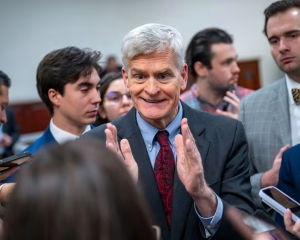Social media took my daughter from me. As a parent, I’m fighting back.
My daughter, Becca Schmill, would have turned 23 this year. Becca was a beautiful, caring person whose smile lit up every room. She had hopes and dreams of her own, but before she was able to begin her first year at the University of Richmond, Becca died after she ingested fentanyl-laced drugs at the age of 18.
Fentanyl may have been the official cause of her death, but the path she went down to get there was paved by social media.
Like many young people at the time, Becca got her first smartphone in middle school. Three years before her death, she was added to an online party chat where she was introduced to a group of 18-year-old boys – one of whom later raped her. She was 15. As she attempted to heal from this trauma, the process was undermined by a humiliating cyberbullying incident. The shame and anguish the assault caused – compounded by the cruelty of a few peers on multiple social media platforms – created a hole inside her heart that Becca tried to fill by self-medicating.
Becca had a loving family and the support of counselors, but social media made it possible for her to find illicit drugs whenever she felt the desire to escape from the pain she felt inside.
Social media was not designed with kids’ best interests in mind
My daughter’s story is singular, but her experience with social media is one that millions of kids face daily. What’s frightening is that when a child experiences online harm, it is often because social media is working exactly as designed. Platforms like Snapchat, Instagram and Facebook use powerful algorithms designed to maximize time spent on their apps. They reward despair and outrage and target the most vulnerable among us.
For kids and teenagers who are at pivotal stages of their mental development, social media hijacks their brains. If young people fall into harm online, there is little that parents can do to intervene. The apps can turn happy lives into nightmares.

When I tried bringing my concerns to the social media platforms, I quickly learned they were not interested in making their products safe for kids. Their primary interest was, and is, to increase engagement so they increase their profits.
Social media platforms, as designed, are not safe for kids. According to research by Jonathan Haidt, renowned social psychologist and New York Times best-selling author, social media is primarily to blame for an epidemic of mental illness among America’s youth.
Depression and anxiety for young people are rising: 1 in 3 teenage girls have reported seriously considering suicide in the past year.
In addition to the mental health concerns, rates of sextortion and drug sales online are skyrocketing. The U.S. surgeon general has rightfully called for warning labels to be put on social media apps, but a lot more needs to be done.
Why aren’t tech companies doing more to protect children on their own?
Big Tech companies choose to put profits first, despite their own internal research showing that their design features are causing harm to children. This is why legislation like the Kids Online Safety Act – which requires tech companies to prioritize kids’ safety in design decisions and enable the strongest safety settings by default – is so important. The bill is a crucial first step.
Beyond legislation, what’s needed is a different kind of digital world where social media and the internet exist to empower and not harm us. What’s needed is a new way forward that creates a better digital experience for everyone – especially kids.
Today, more than 170 million Americans use TikTok, and a significant percentage of TikTok users are under the age of 15.
Behind YouTube, it is the most popular platform for young people. This year, Congress passed a law giving Chinese parent company ByteDance up to a year to sell TikTok’s U.S. operations or face a ban. What happens next will affect every parent and child in this country.
We can begin to realize a new vision for the internet. That is why I’m supporting Project Liberty’s “People’s Bid for TikTok” – and I think other parents should do the same.
The truth is, most kids are on TikTok, and the same problems we find on other apps – cyberbullying, addiction, toxic algorithms – are exciting on that platform. Under Project Liberty’s vision, led by founder Frank McCourt, TikTok would be retooled without its algorithm, addressing many of the harms of social media at their source.
It’s time for us to take control of our digital future
Project Liberty’s plan would also give people control over their data. The platform would be designed for a safer, healthier online experience. And it would finally give people – who the apps call “users” – a voice in our digital future. The People’s Bid for TikTok, in other words, would create the blueprint for a digital world where people are in charge.
Only by creating an alternative to what exists now will the digital landscape change for the better. But I fear the window to act is closing.
If you’re a concerned parent worried about your children and their relationship with social media, I strongly encourage you to start asking the tough questions of yourself and other parents. Have conversations while waiting in line at school pickup, in PTA meetings, on the sidelines of soccer games and at the kitchen table with your family.

As we head into a new school year and you’re considering ways to protect your child, ask yourself: “Are they safe online?” and “Is their relationship with social media healthy?” Keep an open dialogue with your child and let them know that it is OK to talk to you about what they’re seeing on social media – and tell others about how the “People’s Bid” would make TikTok safer and healthier for kids.
If the internet and social media had been designed with safety in mind, my daughter might still be here. I miss Becca every minute of every day and don’t want any other family to go through what ours has. As a parent and as an American, I am fighting for the right to take back control of our online world. I encourage all parents to join me.


